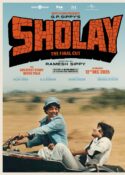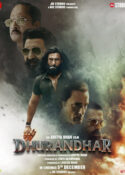 He has brought us epic tales of cricket, of coming home, and of an emperor and his wife to the silver screen. For his next film, he is shining the light on a little known uprising that would change the fate of a country. That director is Ashutosh Gowariker and that uprising is the story of Khelein Hum Jee Jaan Sey. Mr. Gowariker used the book Do and Die: The Chittagong Uprising of 1930-1934 by Manini Chatterjee as a reference to bring this little known tale to life. It is the story of a band of 64 individuals – 56 innocent 13-14 year old boys, five defiant revolutionaries, two determined young women, and an idealistic leader – Surjya Sen, a school teacher by profession, who joined together, trained and began a revolution with five simultaneous attacks on the night of April 18th. The film, which opens Friday, December 3rd, is a period thriller which stars Abhishek Bachchan and Deepika Padukone. The wonderfully nice Mr. Gowariker took time out of his busy schedule to talk to us about KHJJS including what inspired him to make this film, what he hopes audiences will love and much more.
He has brought us epic tales of cricket, of coming home, and of an emperor and his wife to the silver screen. For his next film, he is shining the light on a little known uprising that would change the fate of a country. That director is Ashutosh Gowariker and that uprising is the story of Khelein Hum Jee Jaan Sey. Mr. Gowariker used the book Do and Die: The Chittagong Uprising of 1930-1934 by Manini Chatterjee as a reference to bring this little known tale to life. It is the story of a band of 64 individuals – 56 innocent 13-14 year old boys, five defiant revolutionaries, two determined young women, and an idealistic leader – Surjya Sen, a school teacher by profession, who joined together, trained and began a revolution with five simultaneous attacks on the night of April 18th. The film, which opens Friday, December 3rd, is a period thriller which stars Abhishek Bachchan and Deepika Padukone. The wonderfully nice Mr. Gowariker took time out of his busy schedule to talk to us about KHJJS including what inspired him to make this film, what he hopes audiences will love and much more.
Why did you choose to make this film?
I was very intrigued by this unknown revolution. It’s a revolution that one has read about in school textbooks as one sentence, which is the Chittagong Uprising of 1930. I didn’t know much about it until I discovered the book Do and Die. In the book, I discovered all the details of how this is not just a one person committing an act of bravado, it was 64 people lead by Surya Sen. What shocked me the most was out of these 64 there are 55 teenagers. I started thinking what was I doing for the country… did I have any thoughts for my country when I was 13 years old? I didn’t. So I was fascinated … what were these 13-14-year-olds thinking and what kind of passion did they have that they thought of risking their lives, giving their lives for the freedom of their country? I had to bring this to the screen.
What sort of research did you do to create the world of Chittagong in the 1930s?
Of course, the book itself is the basis of the research. Manini Chatterjee has done some four to five years of research and has written a very detailed account of how the event happened. So the biggest task was to bring this account into the parameters of a feature film. To do that I had to visit Bengal, Kolkatta, visit all the places and try and grab the the contemporary ethos, and then I had to build my way backward to find what will be right thing for 1930. Even in regards to music, social cultural and behavioral patterns and all of that became very, very important especially because these characters actually lived 80 years ago. I think creating any different world of a different era/time is difficult. I feel you need to give it time. My team, Nitin Desai and Neeta, who are the art director and costume designers, they did their research and they brought in their details. It has been a combination of sorts of bringing in different aspects and creating the world. I find it very fascinating and very enjoyable.
Tell us about casting and working with Abhishek Bachchan.
Right from his first film I liked his performance and I had thought that some day, if I have the right kind of script, there will be an opportunity to work together. For the past 10 years it never happened till I came across Do and Die. When I read the description of Surya Sen, the freedom fighter, the face that came to my mind right away was Abhishek. Somehow in all the movies he’s done so far Abhishek has been, to me, a combination of something very rebellious in his persona and at the same time he does have a lot of innocence in him, there is something really pure about him in his face and the look in his eyes. I thought that would be very helpful to portray Surya Sen. I’m glad that it’s worked out and we’ve done this film.
 Why did you think Deepika Padukone would be perfect in this role?
Why did you think Deepika Padukone would be perfect in this role?
I must tell you she has a very uncanny resemblance to Kalpana Dutta, the original revolutionary. It was quite amazing. I had seen Deepika in her movies and I really thought that she has really grown by leaps and bounds with every movie that she has done. This part just suited her. There is a certain degree of modernity that she carries with her in her movies and I thought it would be interesting to see her in the past – in 1930. Kind of have that combination of the actress who is very modern and very stylish and she’s taken a part which is very traditional and very rooted. I thought that combination would help and glad she’s worked out very well.
You also have many young actors in the film. How did you work with them before filming to get them ready to take on these roles?
That was kind of a major operation of sorts because I needed 11 kids who would be the front runners among the 55. So various auditions and screen tests were held and we arrived at the final 11 after three months of auditions and screen tests. What I did was I acclimated them and got them accustomed to the period. We did several readings with them. Then there was the dhotis, which is a very Indian national way of dressing, which is the loin cloth. They had to wear loin cloths in the film and all these kids are city kids and they obviously are not used to wearing the dhotis. So we had to orient them and kind of give them one week of just getting used to the part, just getting used to the outfit, getting them into behavior patterns, which are part of a period film. That preparation helped, but it took about a week before we went into the shoot.
Tell us about creating the outstanding music.
When you make a period film what becomes very important to me is it has to have a contemporary resonance to it, by way of its theme, as well by way of the performances, by way of the music. Unless it has contemporary elements it will not be as endearing and appealing as it should be. Now to reflect that, I thought it was very important to have songs in the film which will reflect the time and various dramatic moments of patriotism, friendship, camaraderie. You know two girls who are very good friends and are on the verge of finishing studies and getting married and settled and all of that and both of them sacrifice their respective lives and give their lives for the revolution… there needed to be a song that reflects that. There needed to be a song that reflects the passion and the spirit of the teenagers. I thought the songs in terms of uses of the instruments, while being a reminder of the past still should have a contemporary resonance and that’s what my brief was to Sohail. Sohail Sen and I had a previous working opportunity in my previous film, What’s Your Raashee? and it became a more comfortable experience this time because we knew each other. It was a different kind understanding and I am really glad we worked on this one.
What do you hope audiences will love about the film?
This is the toughest question by the way (laughs). I will put it this way…what was it that I was feeling when I read the book? One, ashamed that I did not know about this revolution, which was India’s biggest revolution. Two, I did not know that it was teenagers participating in it and I was amazed with that. Three, I felt extremely patriotic and overwhelmed for what they did for our nation at that time. In my heart I felt the need to salute them for what they’ve done. This is what I felt when I read the book and that is what made me decide to make it into a movie. I hope that the audiences feel this emotion when they see the film.









